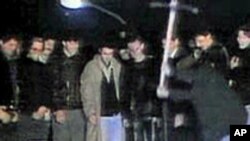For nearly three decades the Berlin Wall was the symbol of the Cold War; it divided a city and in effect the entire country. And then on November 9, 1989 it crumbled and with it Communist East Germany. It was a key event on the path to ending the Cold War.
The Brandenburg Gate - one of Berlin's best known landmarks. Once a stately entryway to the then capital of Prussian kings - by the late 1900's it was part of a grim barrier dividing the city.
In the aftermath of the Second World War, a new conflict was taking shape. The Cold War pitted East against West and nowhere was it more tangible than in Berlin.
It was on this bridge on the outskirts of Berlin that the two sides sometimes met - to exchange spies. Haio Koelling remembers those days. "Yes, I think the exchanges took place right here. The secret agent would be sent out from one military checkpoint to the other - in plain view of both sides," Koellling recalls, "But for us civilians, as of 1961, the bridge didn't exist anymore. We couldn't get close. You could see it from over there, but the Wall blocked it."
The Wall: the defining symbol of Berlin for decades.
It was built in August 1961 by the communist East German government as a physical barrier through the heart of the city. But the Wall encircled all of West Berlin, cutting it off from East Berlin and the rest of East Germany.
It was the most tangible part of the larger Iron Curtain - the dividing line between the West and the Soviet bloc to the east.
It was the focal point of tension and fears the Cold War might erupt into full blown conflict.
But over time, cracks formed in the communist system, says political analyst Jochen Staadt of Berlin's Free University.
"There were some people who knew that the GDR, East Germany is in a bad situation, the economy was going down," Staadt says, "As we now know our secret service they knew a lot about that."
A more obvious signal of change was Soviet leader Mikhail Gorbachev - a reformer at the reins in Moscow.
"When Mr. Gorbachev came to power in the Soviet Union there were signs and one of the most important signs was that people in the Soviet Union started to talk publicly about reunion of Germany," Staadt states.
It sparked a difference of opinion between Moscow and East Berlin. And it was a split western leaders tapped into.
"Mr. Gorbachev, tear down this Wall," US President Ronald Reagan urged.
Change was afoot as President Reagan uttered that now famous challenge in 1987.
Reform movements gained ground within the Soviet bloc and by the summer of 1989 East Germans found a way to the West and peaceful protests spread in East Germany.
While western pressure played a part, the key was Mr. Gorbachev, says political analyst Michael Cox of the London School of Economics.
"I think once the Soviet Union, Moscow, Gorbachev and the Politburo have made that decision not to use force then the whole house of cards is bound to come crumbling down," Cox said.
And crumble it did, faster than anyone anticipated - November 9, 1989. The Wall fell and took with it the East German communist government.
But what would happen next was not a foregone conclusion. Negotiations would follow about the new structure of Europe and how Germany would fit in.
"Because don't forget in 1989 and 1990 when Germany unified many Europeans were worried and therefore it was extraordinarily important for very, very complicated diplomacy to engage Germany within Europe and as an Atlantic player," Cox says, "Don't forget that Gorbachev in the end had to say yes."
Germany was reunited -- the Soviet Union was dissolved; the Cold War drew to a close.
For Haio Koelling too there have been changes. He's now retired, still lives in what was once East Germany. But he can walk across the Glienicke Bridge at will - no barriers, no checkpoints, no walls.









